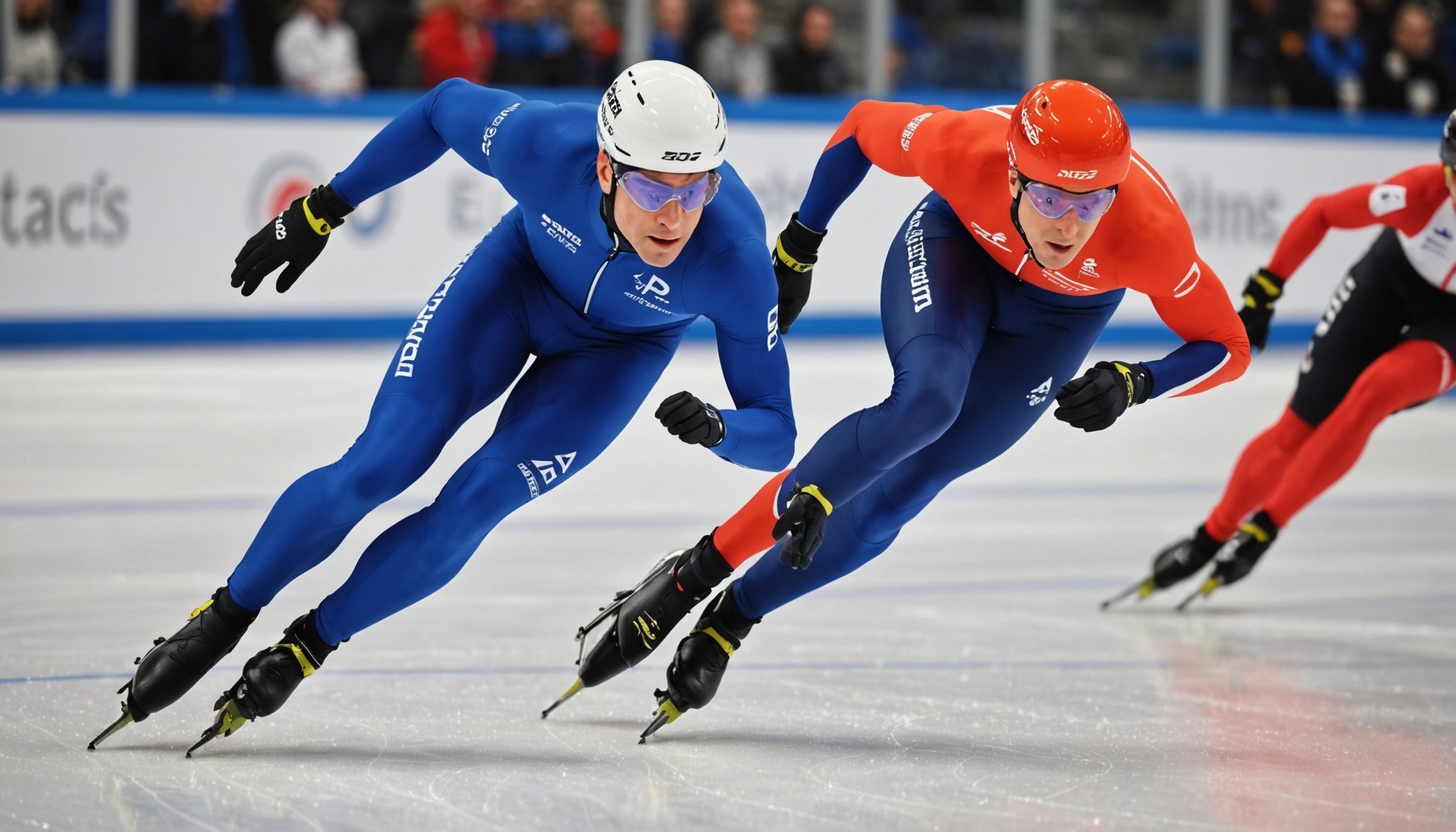Understanding Aerodynamic Drag in Speed Skating
The aerodynamic drag in speed skating is a critical aspect that directly impacts an athlete’s performance. At its core, aerodynamic drag comes into play due to air resistance opposing the skater’s motion. In speed skating, minimising this drag is key to achieving higher speeds.
Physics of Speed Skating
The physics of speed skating revolves around the principles that govern drag forces. Primarily, form drag occurs due to the skater’s shape and posture, influencing how air flows around the body. Skin friction drag results from the air’s interaction with the skater’s skin and clothing. Understanding these types allows athletes to optimise their movement and gear.
Also to see : Revolutionizing cricket bowling: the impact of vr-enhanced training on decision-making skills
Types of Drag in Skating
Speed skaters experience various types of drag:
- Form Drag: Affected by the skater’s body posture.
- Skin Friction Drag: Related to the surface texture of the skater’s outfit and skin.
- Induced Drag: Rare but occurs due to vortices created at the skater’s limbs.
Reducing aerodynamic drag is crucial, prompting athletes to adjust their posture, refine techniques, and choose equipment wisely to enhance performance.
This might interest you : Unlocking speed: the game-changing role of 3d printed custom footwear in enhancing sprint performance
Methodologies for Aerodynamic Drag Analysis
Understanding aerodynamic drag in sports like speed skating requires advanced drag analysis techniques such as computational fluid dynamics (CFD) and wind tunnel testing. Both methods offer insights critical for enhancing athletic performance.
Computational Fluid Dynamics (CFD)
CFD is a powerful tool used to simulate and analyse the airflow around speed skaters. By creating digital models, CFD can predict how minor changes in a skater’s posture or gear affect air resistance. This method provides detailed visualisations of drag forces, enabling skaters and coaches to make informed adjustments to improve speed and efficiency.
Wind Tunnel Testing
Wind tunnel testing is a practical application method for detecting aerodynamic inefficiencies. In controlled environments, skaters can experiment with different postures and equipment settings while real-time data tracks performance changes. The controlled environment allows precise, repeated testing, making it possible to validate CFD simulations and confirm effective drag reduction strategies.
Both CFD and wind tunnel testing play a vital role in understanding and reducing aerodynamic drag. They offer complementary insights and help formulate evidence-based recommendations for skaters. Together, they represent the forefront of performance analysis technology, blending theoretical models with practical application for optimal results.
Case Studies from Elite Speed Skating Competitions
In the realm of elite speed skating, aerodynamic efficiency can significantly determine competitive outcomes. Performance case studies from recent world-class events offer invaluable insights into how top athletes employ aerodynamic drag reduction strategies to gain an edge.
A prominent case is the triumph at the 2021 World Championships, where skaters who fine-tuned their body postures and selected optimised gear saw notable improvements in speed. An analysis revealed that skaters utilising state-of-the-art suits designed for minimal skin friction drag enhanced their glide efficiency. This illustrates the importance of both skating posture and gear in reducing resistance during high-stakes competitions.
At the 2022 Olympics, several athletes adopted unique technique optimisation tactics, such as altering their stride length to ensure maximum coverage with minimal resistance. This strategic variation was crucial in enhancing overall performance. These performance case studies underscore the significance of iterative testing and real-time adaptability.
From these examples, it is clear that successful strategies involve a combination of careful planning, rigorous testing, and analytical approaches. Future practices in speed skating benefit from these insights, encouraging a tailored approach to reduce drag effectively.
Practical Tips for Skaters to Improve Aerodynamic Efficiency
Enhancing aerodynamic efficiency in speed skating can significantly improve performance. One crucial aspect is the skating posture. Skaters should aim for a low, streamlined position to minimize form drag. By bending their knees and keeping their torso parallel to the ice, skaters can reduce air resistance effectively.
Another key consideration is stride technique. Efficient techniques focus on maximizing the distance covered with each stride while minimizing resistance. Skaters should ensure that their strides are both powerful and smooth, maintaining a consistent rhythm that reduces the chance of creating disruptive wake vortices.
Gear selection also plays a fundamental role in optimizing aerodynamics. Skinsuits with smooth surfaces can reduce skin friction drag by allowing air to flow more seamlessly over the body. Choosing suits designed with advanced materials and technology offers an aerodynamic advantage.
Additionally, advanced performance tips include regular testing and refining of techniques and gear. Skaters should continually seek feedback and make iterative adjustments based on performance data. Engaging with coaches who understand the nuances of aerodynamic drag can provide tailored technique optimisation, further refining their approach for better results.
Technologies and Tools for Drag Analysis
In the world of speed skating, performance technology and analysis tools are revolutionising how athletes approach drag analysis. These modern tools are pivotal in tracking and enhancing performance, offering skaters precise data to refine techniques.
Cutting-edge sensors and software tools provide real-time feedback on posture and speed, helping identify drag zones that may need addressing. This allows for immediate adjustments, optimising every aspect of the race. Skaters benefit significantly from performance tracking technology, as it offers detailed insights into how small changes can lead to measurable improvements.
One promising trend in this sphere is the development of advanced analytics that integrate data visualisation platforms. These tools synthesise complex data sets into accessible visual formats, making it easier for coaches and athletes to understand and act upon.
Future advancements in these tools promise even more nuanced aerodynamic analysis, focusing on hyper-specific metrics previously unavailable. The integration of AI and machine learning algorithms into these technologies could further personalise training regimens, predicting conditions under which drag might be minimised, thus continuing to push the boundaries of speed and efficiency in competitive skating.
Expert Insights and Perspectives
Gain unique expert commentary to deepen your understanding of speed skating dynamics. Coaches emphasize the crucial role of aerodynamic principles in training. They stress the importance of tailored skating programs that incorporate rigorous drag analysis. By adjusting posture and adopting advanced performance technology, skaters can achieve greater aerodynamic efficiency.
Athlete interviews offer their perspective on tackling drag. Top skaters reveal their focus on technique optimization, sharing insights on refining posture and gear to minimize resistance. This engagement with technology aids in identifying precise improvement areas.
Coaches suggest a comprehensive checklist for developing programs:
- Incorporate analysis tools like computational fluid dynamics (CFD) to visualize drag forces.
- Use sensors to provide real-time feedback on skating posture and technique adjustments.
- Regularly update training regimens based on performance data, integrating current research.
This multifaceted approach helps athletes to better comprehend and control drag, ensuring they remain competitive. Explore these avenues to revolutionize your method and stay ahead in the fast-paced world of elite speed skating.











